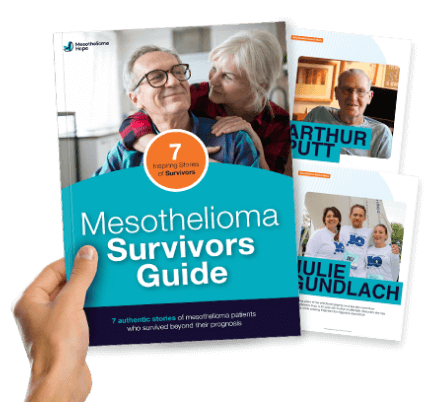What Is Navelbine?
Vinorelbine, known by the brand name Navelbine, is a vinca alkaloid chemotherapy drug derived from the periwinkle plant. Vinca, or plant alkaloids, are semi-synthetic, meaning they are partially chemical and partially plant.

Navelbine was approved by the U.S. Food and Drug Administration (FDA) for the treatment of non-small cell lung cancer in 1994. Over the past few decades, researchers have studied it as a viable chemotherapy drug for the treatment of pleural (chest) mesothelioma.
Studies have shown that Navelbine is not as effective in increasing survival rates and life expectancy in comparison to pemetrexed-cisplatin treatments.
However, researchers are looking at Navelbine as a potential line of treatment following a patient’s first round of therapy. There is some evidence that it can relieve pain and improve quality of life without shrinking tumor mass.
For these reasons, Navelbine is being studied as a palliative treatment (relieving pain without curing the illness) or maintenance treatment to extend a patient’s remission.
A mesothelioma diagnosis can be scary, but treatments like Navelbine can help. Learn which treatments helped other patients live for years or even decades in our Free Survivors Guide.
How Is Navelbine Administered?
Navelbine chemo can be administered in two different ways: orally or intravenously. The benefits and effects of both treatment methods, along with dosing variations, are currently being studied in clinical trials.
Intravenous Administration
If administered through an intravenous (IV) drip, patients are generally given Navelbine in several cycles, each around half an hour long.
Results have been most favorable when treatments are given weekly, in dosages between 20 mg and 30 mg.
Doctors may vary treatment cycles depending on whether Navelbine is being prescribed for second-line, palliative, or maintenance reasons.
Oral Administration
Patients who take Navelbine capsules can do so in the comfort of their own homes.
Oral doses of 20, 30, and 80 mg exist. A doctor will prescribe a specific dose depending on a patient’s personal characteristics and health goals.
More severe side effects are seen when the drug is taken orally. Patients need to be careful that the capsules are not damaged since punctures can cause mouth sores and localized pain.
How Does Navelbine Treat Mesothelioma?
Chemotherapy drugs treat various types of cancer by interfering with cell growth — either by causing cell death or problems in cell-cycle regulation.
Healthy cells duplicate their DNA and then divide into new cells. However, after about 50 divisions, healthy cells are programmed to die (apoptosis). Programmed apoptosis helps to prevent abnormalities and ensures genetically mutated cells are removed from the body.
When healthy cells become cancerous, they are extremely dangerous because they lose this programming and replicate and spread at increased rates.
Chemotherapy drugs used to treat mesothelioma are able to kill cancerous cells in tumors or small lumps found in the mesothelial lining of the chest, abdomen, and heart.
Navelbine is classified as an antineoplastic agent. This means that it is able to bind to microtubules (microscopic tubes in cells). Microtubules are seen in the last stages of cellular division as they help cells split their DNA between two new cells.
When Navelbine binds to microtubules, mesothelioma cells are unable to divide, which leads to their self-destruction.
A current clinical trial suggests that in order for Navelbine to have an effect in treating mesothelioma, a gene called BRCA1 is needed in order to induce cell death.
This gene has been shown to be absent in 38% of mesothelioma cases. This study is trying to establish whether patients treated with Navelbine live longer and whether patients should be tested for the BRCA1 gene before being given Navelbine.
Navelbine Drug Combinations
Mesothelioma cells are often resistant to cytotoxic (toxic to cells) treatment. This resistance may be due to cells’ built-in apoptosis resistance.
For this reason, doctors generally combine chemotherapy drugs that work to kill cancer cells through different mechanisms.
Studies have also shown that chemotherapy treatments with single agents achieve low response rates in mesothelioma patients, generally around 20%.
Navelbine has been administered on its own as well as in combination with other drugs through various clinical trials treating pleural mesothelioma.
In patients who did not receive any previous chemotherapy treatments, combinations of Navelbine and cisplatin (an FDA-approved chemotherapy drug for mesothelioma) have been used. In addition, Navelbine has been used with oxaliplatin, which is a drug commonly used to treat renal and colon cancer.
As a form of first-line treatment, Navelbine chemotherapy has been given as part of a triplet regimen in combination with cisplatin and gemcitabine, which is commonly used to treat pancreatic and ovarian cancer.
When Navelbine is used as a first-line treatment, either on its own or with other drugs, significant toxicities were reported. As a result, it is now being investigated as a second-line and palliative treatment method in combination with gemcitabine.
Use our Free Doctor Match to find doctors who can recommend pleural mesothelioma treatments.
Current Navelbine Clinical Trials
Navelbine is currently approved by the FDA to treat non-small cell lung cancer. However, clinical trials have been ongoing for many years to test its ability to treat mesothelioma — pleural mesothelioma in particular.
Clinical trials are used to assess whether a drug is safe and effective in treating a disease.
Every clinical trial has various phases numbered from 1 to 4. Each phase increases in treatment group size and monitors the side effects and results experienced by each patient.
The FDA requires drugs to pass through all four clinical trial phases before being administered to the public.
Navelbine Research Update
A phase 2 clinical trial that is studying the effectiveness of Navelbine as a single-agent first-line treatment is showing a partial response rate of 24% and a stable disease rate of 55% with 21% of patients experiencing disease progression during treatment.
Another clinical trial is comparing the effectiveness of Navelbine in patients with non-small cell lung cancer and mesothelioma.
Clinical trials are also testing Navelbine in its ability to treat mesothelioma recurrence as a second-line treatment. These trials include a phase 2 study comparing anetumab ravtansine and Navelbine as single agents and another phase 2 trial studying orally ingested Navelbine as a single agent.
Navelbine is also being compared against gemcitabine and antibody immunotherapy as a third-line cancer treatment for patients with advanced pleural mesothelioma in a phase 3 trial.
Navelbine and Palliative Care
As mentioned above, Navelbine has shown promise as a viable treatment for palliative care to improve patients’ quality of life who are unable to tolerate other treatments.
There is currently a phase 2 clinical trial being conducted to compare the palliative therapy effects of mitomycin, vinblastine, and cisplatin versus navelbine alone.
Patients who are interested in participating in a clinical trial should talk to their doctor to find out if they are eligible and learn the possible benefits and risks.
Learn about which treatments helped other pleural mesothelioma patients become long-term survivors — and eased their pain — in our Free Survivors Guide.
Navelbine Side Effects
The side effects of Navelbine are similar to other chemotherapy drugs that are unable to distinguish between cancerous cells and healthy cells.
Navelbine destroys healthy cells throughout the body, which causes patients to experience negative side effects. Patients who take the drug orally are more likely to have more severe side effects.
Common side effects include:
- Anemia
- Constipation
- Low red and white blood cell counts
- Mouth sores (when taken orally)
- Muscle weakness
- Nausea or vomiting
- Tiredness
- Weight loss
Less common side effects include:
- Abdominal pain
- Chest pain
- Diarrhea
- Hair loss
- Internal bleeding
- Pain around the injection site (when given by IV)
- Peripheral neuropathy (numbness or tingling in limbs)
- Shortness of breath
Some patients may have an allergic reaction to Navelbine. Doctors will periodically order blood tests to check blood cell counts and kidney and liver function tests. With decreases in blood cells, white blood cells in particular, a patient’s immune system can become compromised. This can lead to a higher risk of infection.
Patients should tell their health care professionals about any over-the-counter medications or supplements that they are taking. Additionally, they should tell their oncology team about any side effects. Treatment may be stopped if extreme or severe side effects are experienced.
Remember: Getting treated is the best way to live longer with mesothelioma. Get our Free Mesothelioma Survivors Guide to find inspiring stories of patients who have lived for many years with this cancer.
Navelbine FAQs
What is Navelbine used to treat?
Navelbine is a plant-based chemotherapy drug used to treat different types of cancer, including:
- Advanced breast cancer
- Hodgkin’s disease
- Non-small cell lung cancer
- Ovarian cancer
Currently, current clinical trials are looking at whether Navelbine — either by itself or with other drugs — may be an effective treatment option for patients suffering from pleural mesothelioma.
Does Navelbine cause neuropathy?
One side effect of the chemotherapy drug Navelbine is peripheral neuropathy, a painful condition that causes numbness and tingling in the arms and feet.
About 1 in 4 people who are treated with Navelbine develop peripheral neuropathy.
If the condition is severe, Navelbine treatment may be stopped.
How long does Navelbine work?
Navelbine works differently for each person. Some people may experience relief from their symptoms for several months, while others may have relief that lasts for a few years. Talk to your doctor about what to expect from your treatment with Navelbine.
How do you take Navelbine?
Patients either receive Navelbine through an IV, or they can take a capsule by mouth. There are benefits to each method.
For example, people who take Navelbine orally do not have to travel to a medical center. However, the pill version of the drug has been associated with harsher side effects.



